A coffee table does way more than just hold your remote and coffee mug. It sits at the heart of your living room and honestly deserves a little extra attention.
Remember to repin your favorite images!
When you style it right, your coffee table can take your space from plain to magazine-worthy with just a few thoughtful touches.
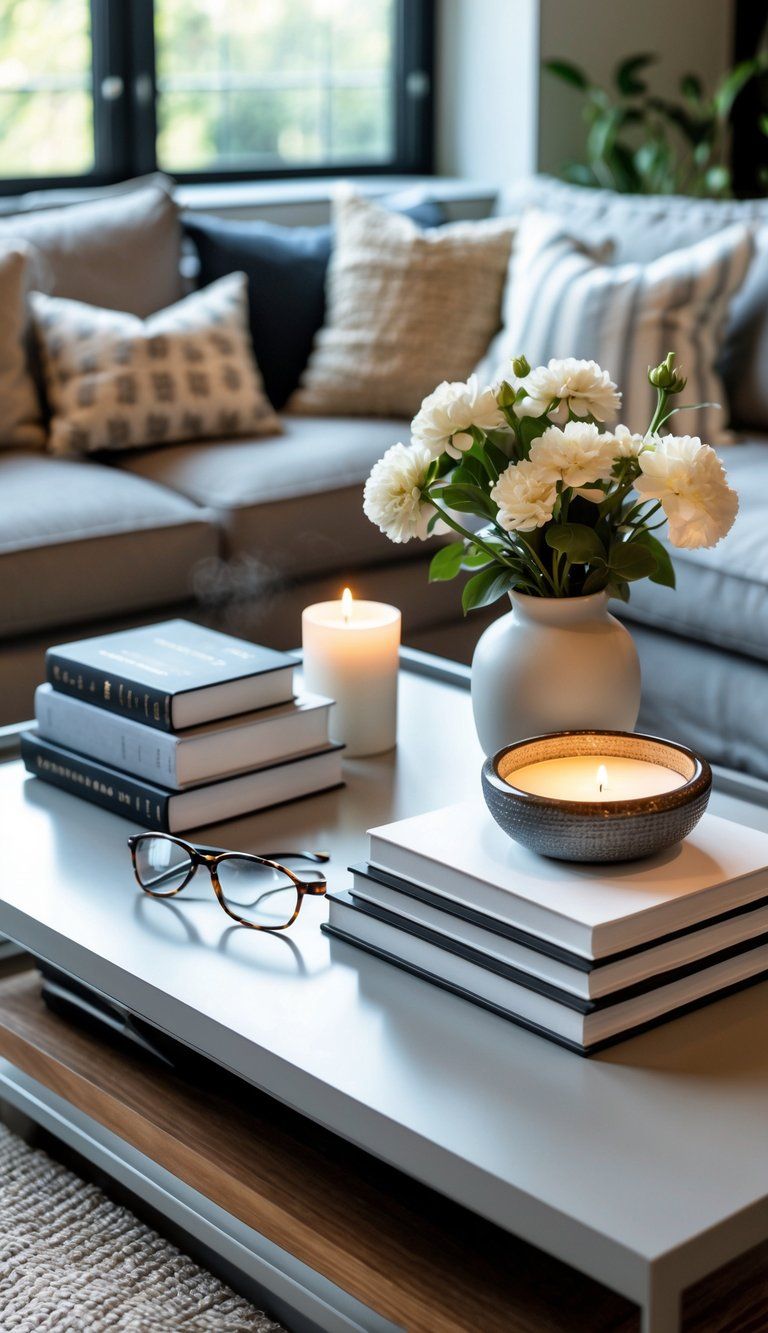
Creating a beautiful coffee table arrangement means balancing different elements—books, decorative objects, flowers, and useful items. Think of your table as a mini canvas where height, texture, and color play together to keep things interesting, but not messy.
You really don’t need pricey décor to get a designer look. When you use what you already have and arrange it intentionally, the results can be stunning.
Follow basic guidelines about grouping, scale, and adding personal touches. You’ll style your coffee table like a pro—effortless but clearly thought out.
Understanding the Role of a Coffee Table in Interior Design
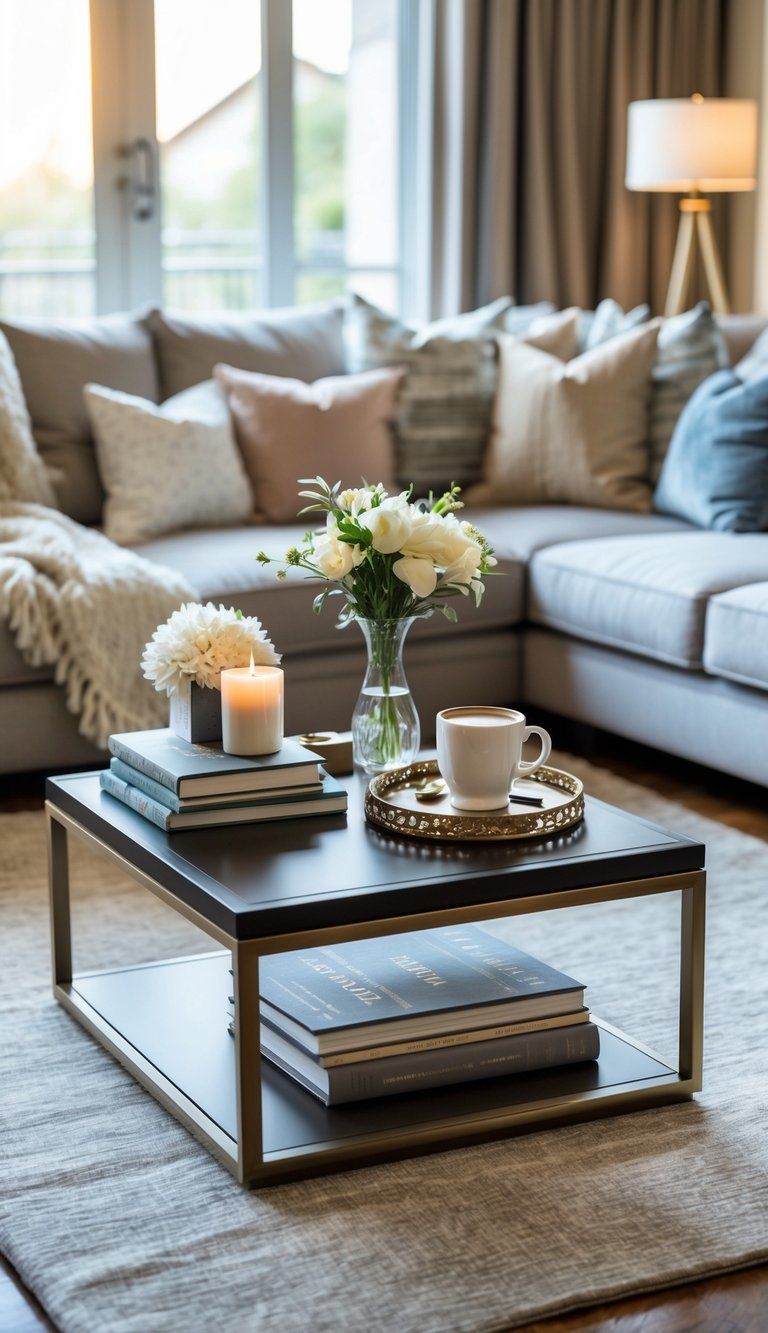
Coffee tables do much more than hold drinks and magazines. They create a focal point and tie your seating together while showing off your personal style.
How Coffee Tables Anchor the Living Room
Coffee tables sit right at the center of your seating area. They naturally draw people together for conversation.
If you place your coffee table about 18 inches from the sofa, you’ll find it’s easy to reach but doesn’t block the walkway.
Coffee tables add visual weight, grounding your furniture so the room feels connected. Without one, sofas and chairs can look like they’re just floating around.
What you put on your table matters. The designer’s “rule of thirds” helps—divide the table into three sections and build a triangle with books, decorative pieces, and useful items.
The Impact of Coffee Table Size and Shape
Your coffee table’s size and shape really change how your living room feels and works. Ideally, the table should be about two-thirds as long as your sofa.
Square tables fit well in small spaces or rooms with seating on all sides. They give everyone equal access and keep things structured.
Round coffee tables soften up rooms that have a lot of sharp angles. They’re also safer for kids and make it easier to move around.
The height makes a difference. Aim for your coffee table to be even with or just under your sofa’s seat, so it’s comfortable to use.
Material choice sets the vibe. Glass tops open up small spaces, wooden tables add warmth, and stone surfaces feel luxe (though they’re a bit more work to keep clean).
Principles of Styling a Coffee Table Like a Magazine Editor
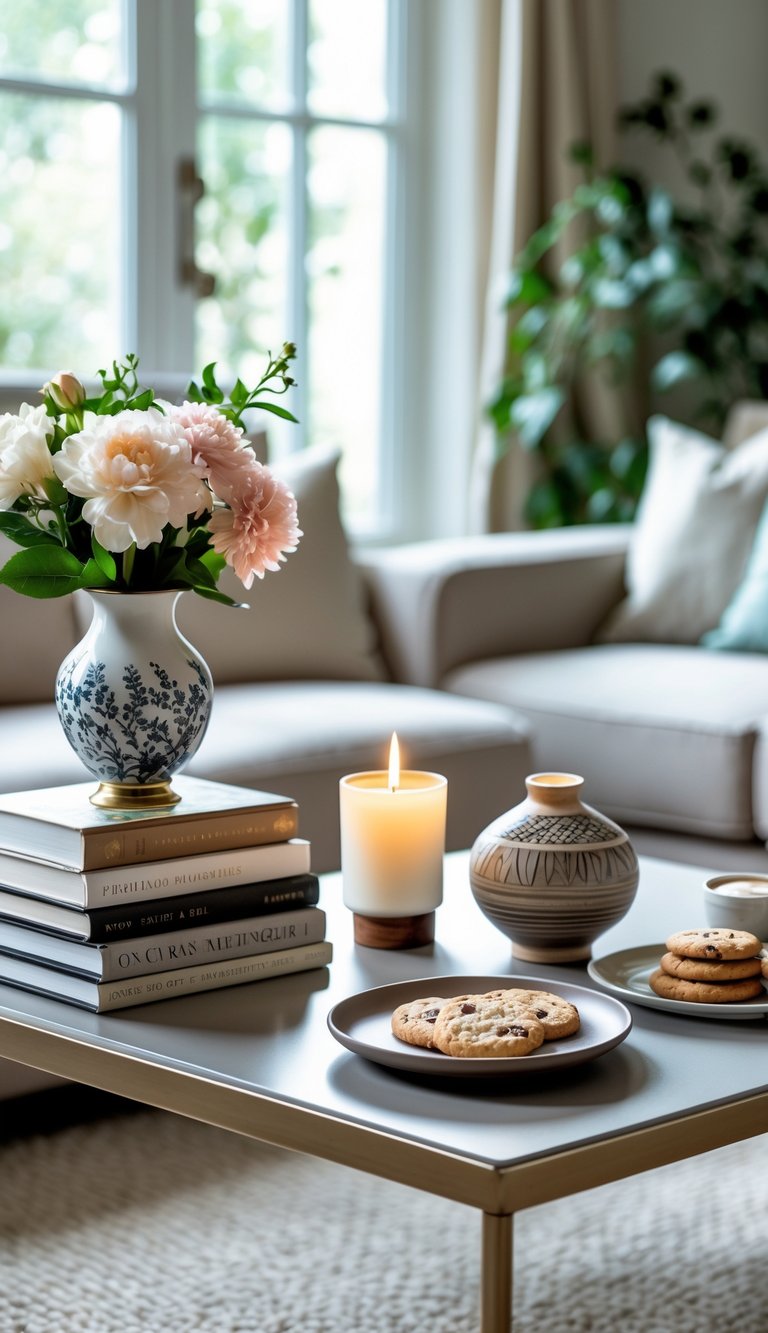
Magazine editors have their go-to tricks for styling coffee tables. These design moves create balanced, eye-catching setups that look curated but not fussy.
Applying the Rule of Thirds
The 3B Theory, or rule of thirds, is a classic editor trick. Divide your table into sections for a balanced look.
Pick three types of things: books, botanicals (plants or flowers), and beautiful objects. These categories play well together and show off your style.
Group items instead of spreading them out. Try books on one side, a plant in the corner, and a decorative piece in the last spot.
If your table is rectangular, picture a grid with nine squares. Place your main pieces where the lines cross for extra impact.
Don’t overfill the table. Leave about a third of the surface empty so things look intentional and not crammed.
Achieving a Layered Look
Layering adds depth and makes your coffee table more interesting. It turns a flat setup into something with real dimension.
Start with a base piece like a decorative tray or a big art book. Trays corral smaller items and define a space.
Add a middle layer with medium things—maybe smaller books, candles, or a decorative box.
For the top layer, include a personal touch—a travel souvenir, a tiny sculpture, or something quirky. These invite people to take a closer look.
Mix up materials between layers. A metal tray on wood, or ceramics on glass, keeps things visually interesting.
Using Varying Heights for Visual Interest
Mixing up heights keeps your coffee table from looking flat and dull. Editors always think about the vertical dimension.
Arrange items so they form a gentle slope. Put a taller piece (like a vase or candlestick) at one end and step down to flatter items.
Try these height ideas:
- Tall: Vases, sculptural pieces, candlesticks (8–12 inches)
- Medium: Stacked books, medium plants, decorative boxes (4–7 inches)
- Low: Coasters, small trays, flat objects (0–3 inches)
Keep tall things on the edges or corners so they don’t block conversation. No one likes peeking around a giant flower arrangement.
Make sure your items fit the table’s scale. A tiny trinket gets lost on a big table, and a huge vase can overwhelm a small one.
Working with Natural Materials
Natural elements bring life and texture to your coffee table. Editors love adding something real for warmth and authenticity.
Try to include a living thing if you can. A little plant, fresh flowers, or even an interesting branch adds shape and color that fake stuff just can’t match.
Mix up textures—smooth glass or metal with rough baskets, pottery, or stone. This combo makes people want to touch and look closer.
Swap in seasonal natural accents to keep things fresh. Shells in summer, pinecones in winter, or bright leaves in the fall give your table a quick update.
Natural materials keep your arrangement grounded. A wooden bowl, stone coaster, or ceramic vase connects your décor to the real world.
Curating the Perfect Coffee Table Books
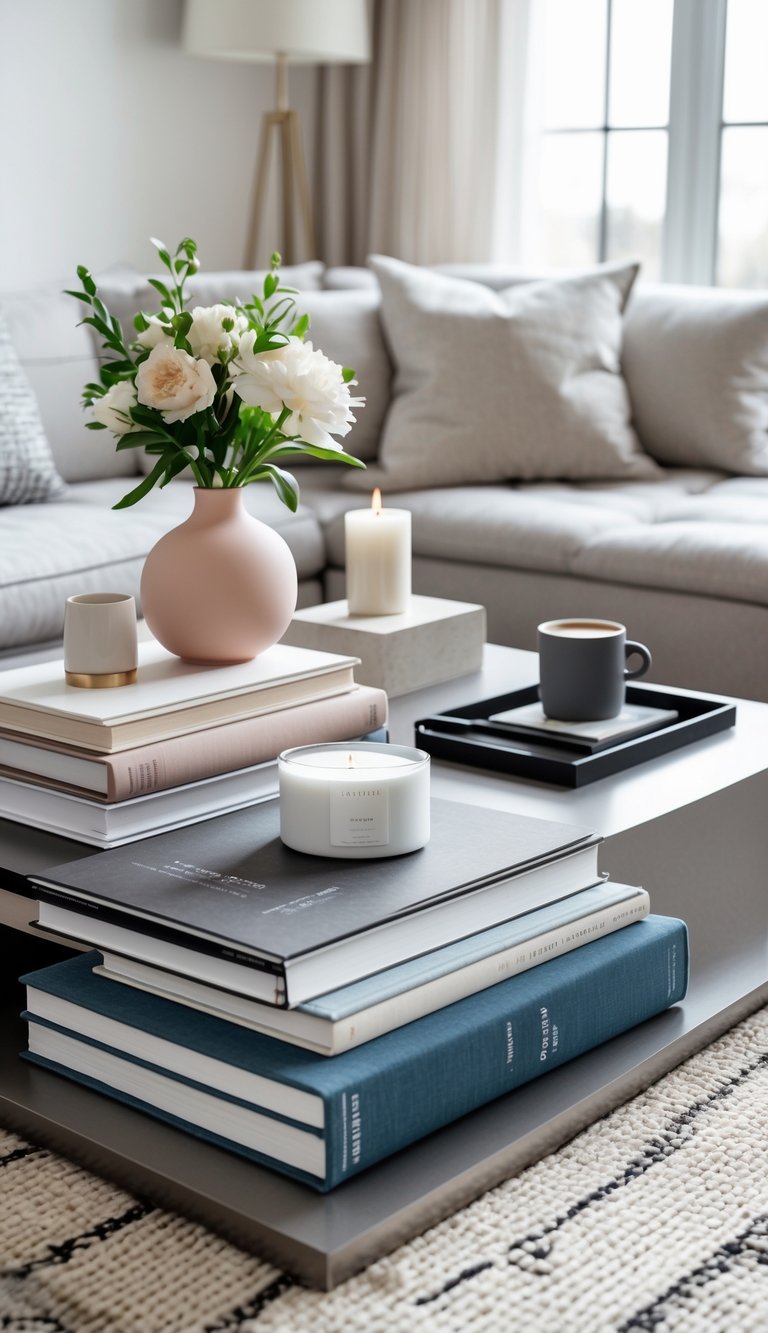
Coffee table books show off your personality and style. They double as décor and spark conversation when friends come over.
Selecting Topics for Coffee Table Books
Pick books that match your interests and fit your home’s vibe. Art, travel, photography, fashion, and architecture all work well.
If you like a tidy look, go for books with neutral covers. Designers like Rachel Little suggest simple covers, like “Perspective” by Steven Gambrel or “Home” by D. Stanley Dixon.
Try taking off dust jackets—they can make things look messy, and the hardcovers underneath are usually sleeker.
Choose books you actually care about. The best coffee table books are the ones you’ll want to flip through, not just display. Architectural Digest’s 100th-anniversary edition is both pretty and worth reading.
Arranging a Stack of Books
Stack books in different heights for interest. On rectangular tables, arrange 2–3 neat piles for a layered effect.
Put the biggest books at the bottom and smaller ones on top. This keeps things stable and looks good.
Use book stacks to boost other objects. A small pile can lift a sculpture, plant, or candle and add depth.
Leave some books closed, but open others to cool pages. It makes your space feel lived-in, not staged.
Balance your books with other décor—maybe a small tray, decorative box, or fresh flowers. This keeps the table from feeling crowded or flat.
Incorporating Decorative Objects
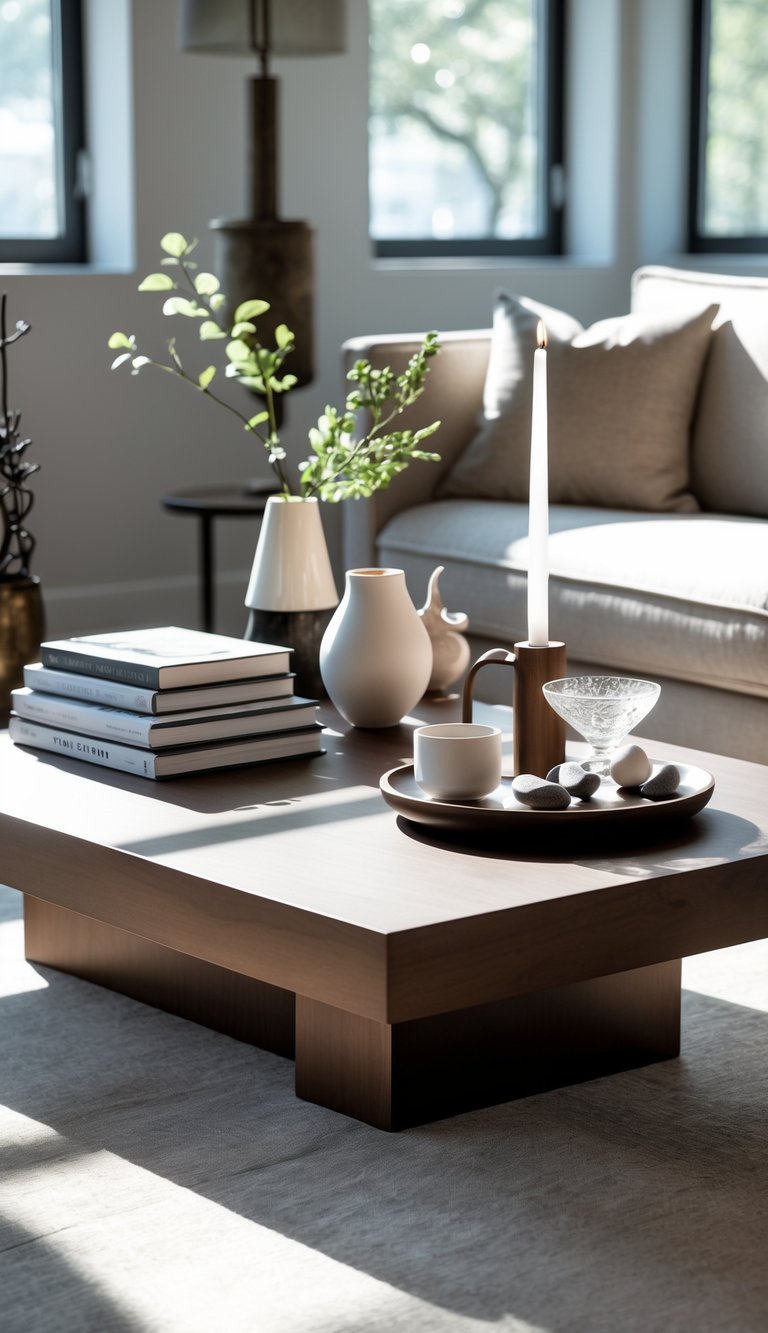
Decorative objects give your coffee table personality. They turn a plain surface into a statement and make your living room feel more like you.
Showcasing Bowls, Boxes, and Unique Pieces
Bowls work great as coffee table accents. They add height and can hold small treasures or even remote controls.
Glass or wooden boxes look sophisticated and keep things organized. Choose ones with interesting textures or finishes to match your décor.
Sculptures, figurines, or artifacts tell your story. Show off a travel souvenir or something handmade by a local artist. Vary the height and material for extra interest.
Swap out decorative pieces with the seasons—shells in summer, metallics for winter holidays. It keeps your table from feeling stale.
Balancing Decorative Elements
Balance matters when you arrange your table. Odd numbers of objects (three or five) usually look best.
Try these proportions:
- Big tables: 3–5 decorative objects
- Small tables: 1–2 statement pieces
Mix up materials and textures. Pair smooth ceramics with rough wood, or shiny metal with matte finishes. This keeps things interesting.
Vary the heights so your setup doesn’t look flat. Place taller pieces at the back or center, and keep shorter ones in front.
Leave some space open. Your coffee table needs room to breathe—aim for about a quarter of the surface to stay clear for both looks and function.
Adding Greenery and Flowers
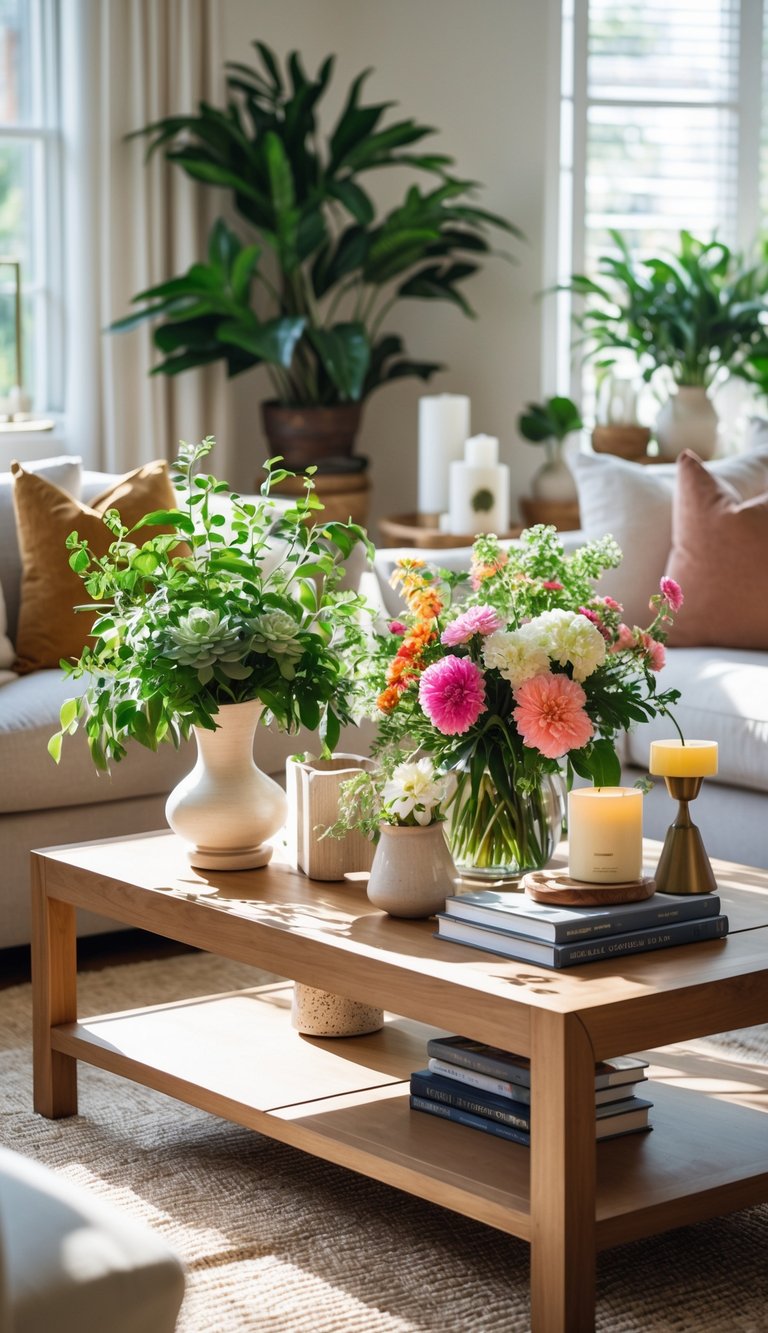
Plants and flowers instantly liven up your coffee table. They add color, texture, and a natural vibe that makes your space feel finished.
Choosing the Right Greenery for Your Space
Small succulents are perfect for coffee tables. They’re low-maintenance and come in tons of shapes.
Pop them in decorative pots that work with your color scheme.
Snake plants and ZZ plants handle low light, so they’re great for indoors. For tiny tables, try air plants—they need no soil and look cool in creative containers.
Pick plants that fit your table. Big tables can handle a statement plant; small tables look better with tiny potted herbs or mini cacti.
The plant’s shape helps, too. Bushy plants soften sharp-edged tables, while tall, structured ones add height to round tables.
Arranging Fresh and Faux Flowers
Fresh flowers brighten up a coffee table right away. For the best look, choose colors that go with your room. Single-type arrangements usually feel more elegant than mixed bunches.
Use a clear glass vase for a clean vibe, or a ceramic one for something heavier and more grounded. The container should match your style but not steal the show.
If you want something that lasts, quality faux flowers work surprisingly well these days and need zero care.
When arranging, stick to odd numbers—three or five stems usually look more natural. Mix up the heights for a relaxed, interesting look.
Seasonal touches like spring branches or winter pinecones keep your table feeling fresh all year.
Personalizing with Collections and Signature Items
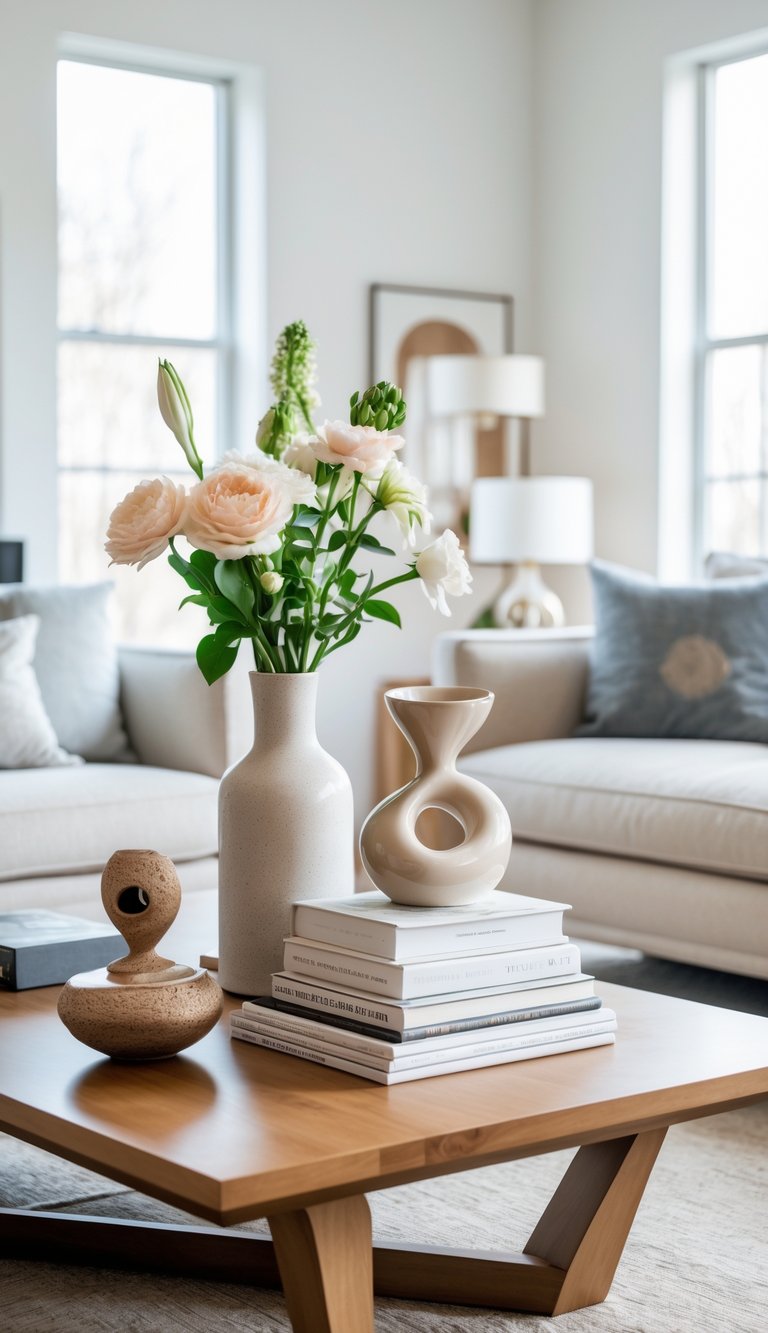
Adding personal touches to your coffee table turns it from just another surface into something that feels truly yours.
A favorite collection or signature piece starts conversations and keeps your space unique.
How to Display a Collection Creatively
Group similar items together instead of spreading them all over the table. That way, you get a stronger visual impact and avoid a cluttered mess.
If you have vintage matchbooks, toss them in a clear glass bowl. Or maybe pick three to five seashells from your favorite beach trip and set them on a small tray.
Think about height when you’re arranging things. Put taller pieces toward the back, and slide the shorter ones up front to add a bit of depth.
Here are a few creative ways to show off your collections:
- Grab a shallow decorative box for corralling small stuff.
- Stick with odd numbers—groups of 3 or 5 just look better.
- Play with color stories by grouping items in shades that work together.
Switch up your display with the seasons to keep your coffee table feeling fresh.
Highlighting Personal Touches Without Clutter
When it comes to personal touches, less really is more. Pick one to three meaningful items and let them shine.
A single special piece—maybe a sculpture from your travels or a family heirloom—often says more than a bunch of little things.
Balance those personal pieces with practical ones. Your favorite ceramic bowl looks great next to a stack of books or magazines you actually read.
Try these clutter-free tricks:
- Replace, don’t just add: If you bring in something new, take something else away.
- Use a single statement piece to draw the eye.
- Pick items that are both meaningful and beautiful.
Give your favorite things a little breathing room. Empty space lets them stand out and makes your guests notice what matters to you.
Styling for Different Coffee Table Shapes
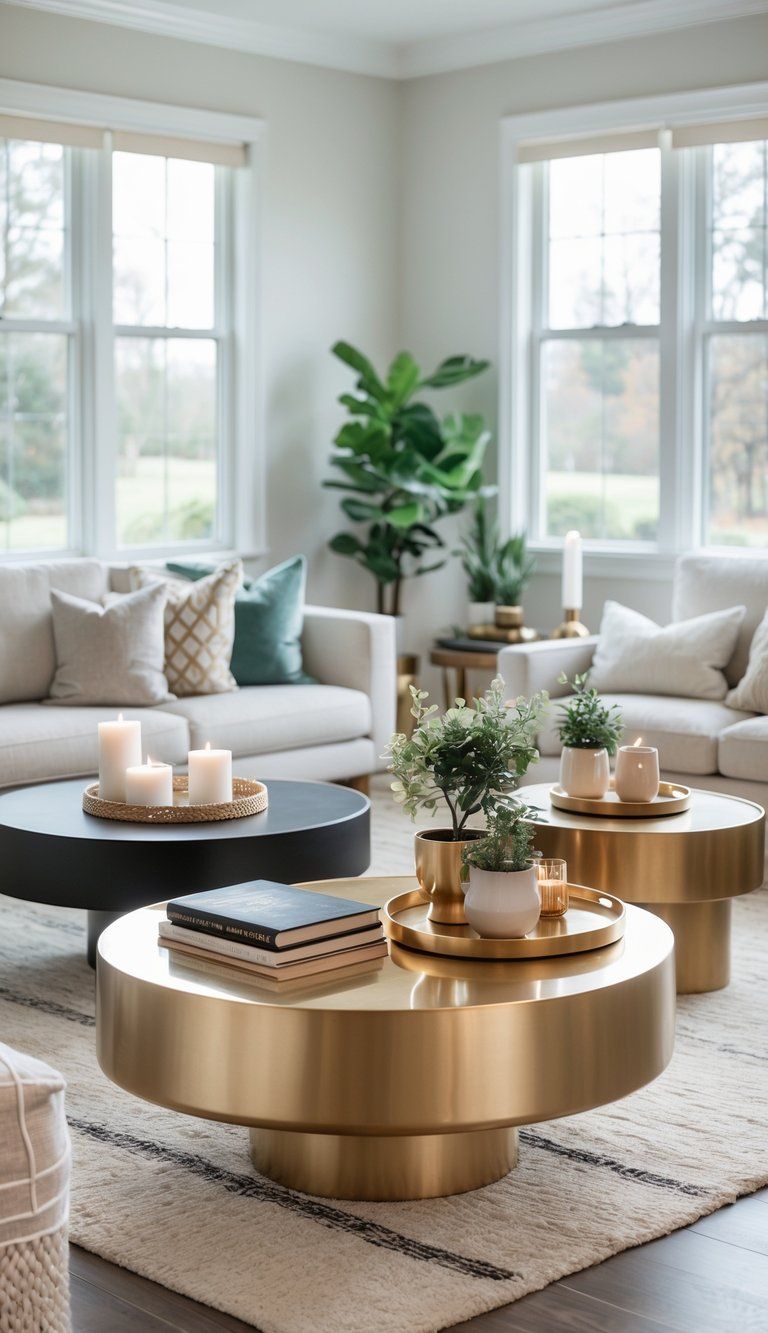
The shape of your coffee table really affects how you style it. It changes how things look and how your eyes move around the setup.
Approaches for Round Coffee Tables
Round coffee tables bring a more natural flow to your space. They’re great for softer, more relaxed styling.
Try breaking your round table into thirds to balance things out.
A few ideas to get you started:
- Pop a circular tray in the center to anchor your display.
- Place taller items near the middle, not the edge.
- Stick to odd numbers—3 or 5 objects usually look best.
- Add curved objects that echo the table’s shape.
Mix things up by adding square boxes or rectangular books to a round table. The contrast grabs attention.
A small plant or fresh flowers always adds a nice touch of life and softness.
Best Practices for Square Coffee Tables
Square coffee tables give you structure and clear corners to play with. Their symmetry is kind of a blank slate for styling.
Try dividing the table into four sections.
You could set a large decorative box or book stack in one corner. In another, use a decorative tray for smaller items.
Leave one section mostly empty so things don’t get crowded.
Vary the height of your objects. Pair a tall candlestick or sculpture with a low stack of books.
The 3B theory works well here—think boxes, bowls, and brass for a designer vibe.
Toss in something personal, like a quirky memento or unique object, to spark conversation.
Maintaining Your Coffee Table Style
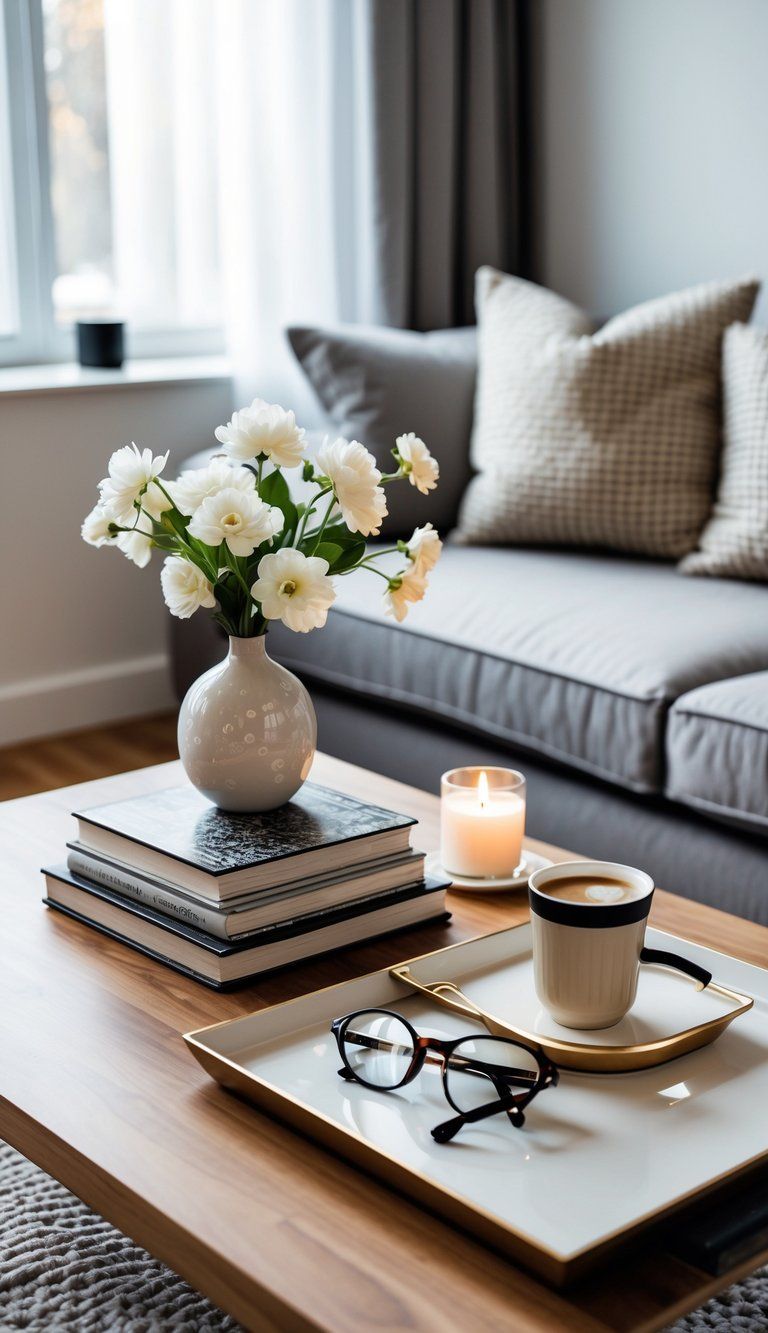
If you want your coffee table to look good and work for you, give it a little attention now and then. Even the best setups need a refresh once in a while.
Refreshing Decor with the Seasons
Seasonal changes are a great excuse to update your coffee table. In spring, try a vase with fresh tulips or daffodils for a pop of life.
When summer rolls in, swap in lighter touches—a bowl of seashells, maybe a citrus-scented candle.
Fall’s your chance to bring in warmer tones. Trade summer pieces for mini pumpkins, gourds, or amber and rust vases.
For winter, go for metallic accents, pine cones, or a little bundle of evergreens.
You really don’t need to change everything. Keep your favorite books or a special tray as the base, and just swap out a couple of items each season.
Honestly, it saves money and keeps things feeling current without a lot of effort.
Tips for Keeping Your Arrangement Functional
You want your coffee table to look good, but it also needs to work for you. Try to leave some open space for things you actually use—remote controls, drinks, snacks, whatever ends up there. I usually aim for about 30% of the table to stay clear.
Here are a few things that help:
- Decorative boxes work great for hiding remotes and other small stuff.
- Coasters should be easy to grab, so you don’t end up with water rings.
- Mix up the heights of your objects. It keeps things interesting but won’t block anyone’s view.
I like to dust everything off with a microfiber cloth once a week. Every month or so, I just take everything off and wipe down the whole table.
Your coffee table’s got to work for your family and any guests you have over. If something pretty turns out to be a hassle, just swap it for something that looks good and actually makes sense.

